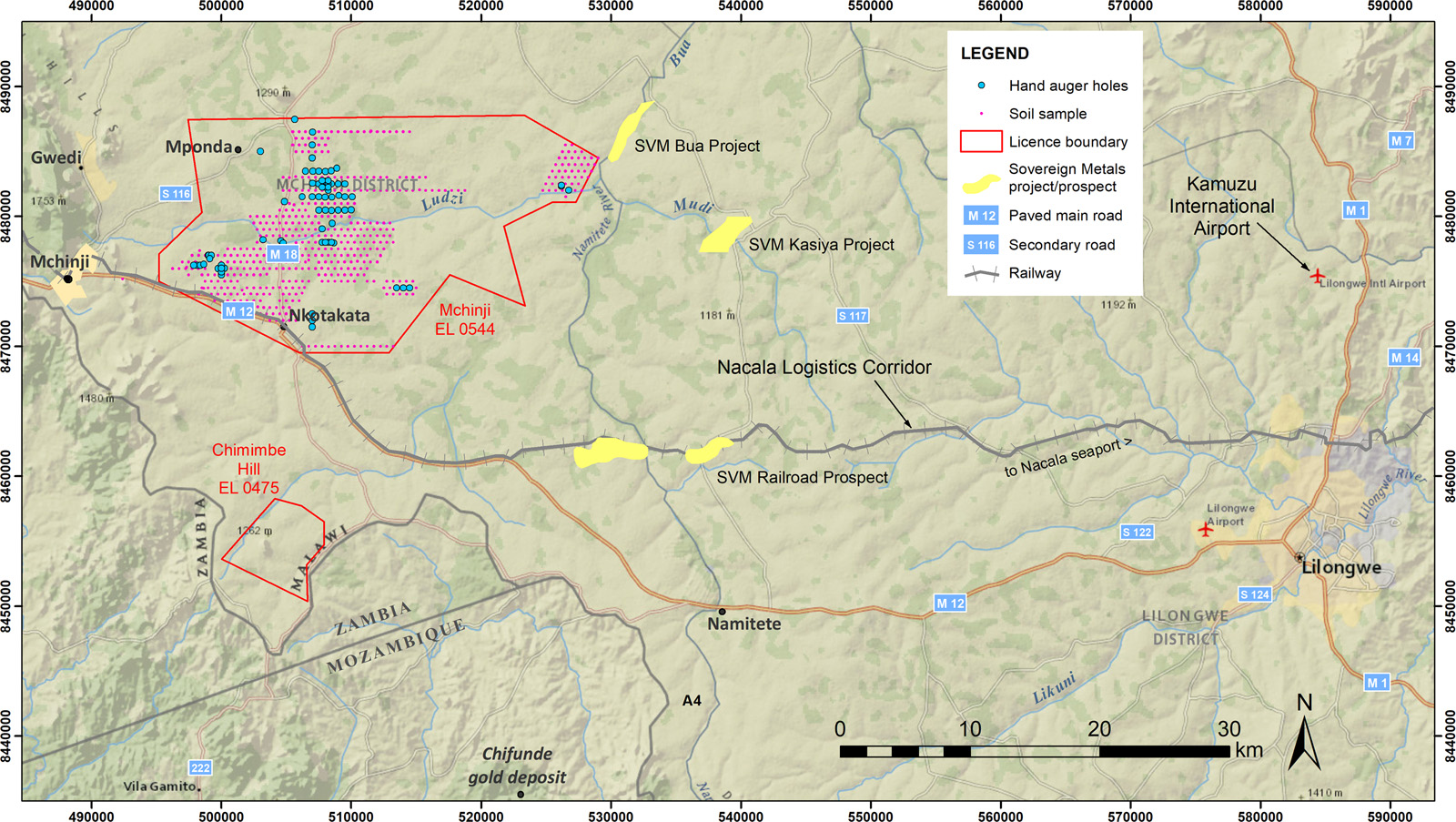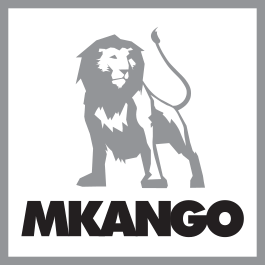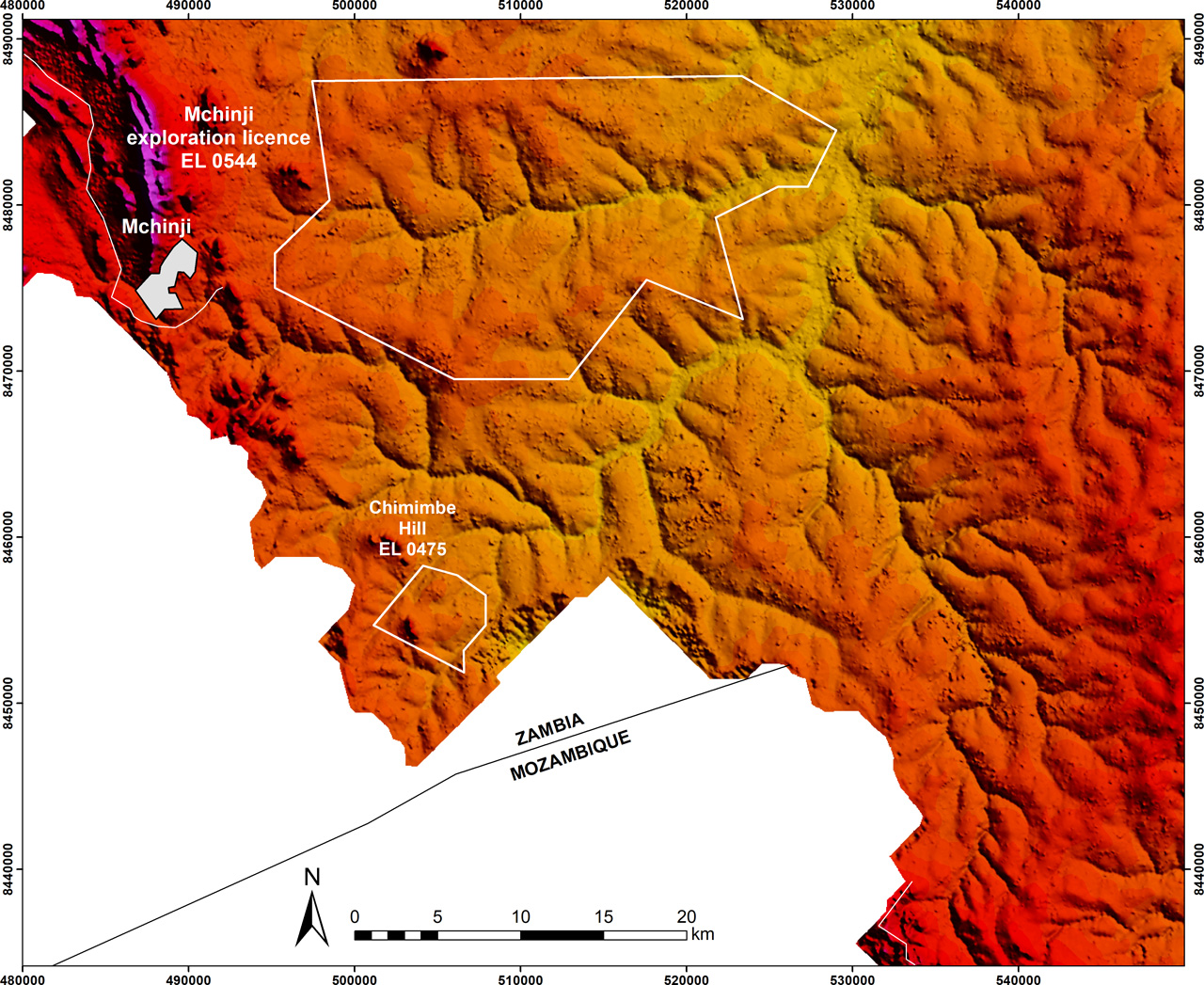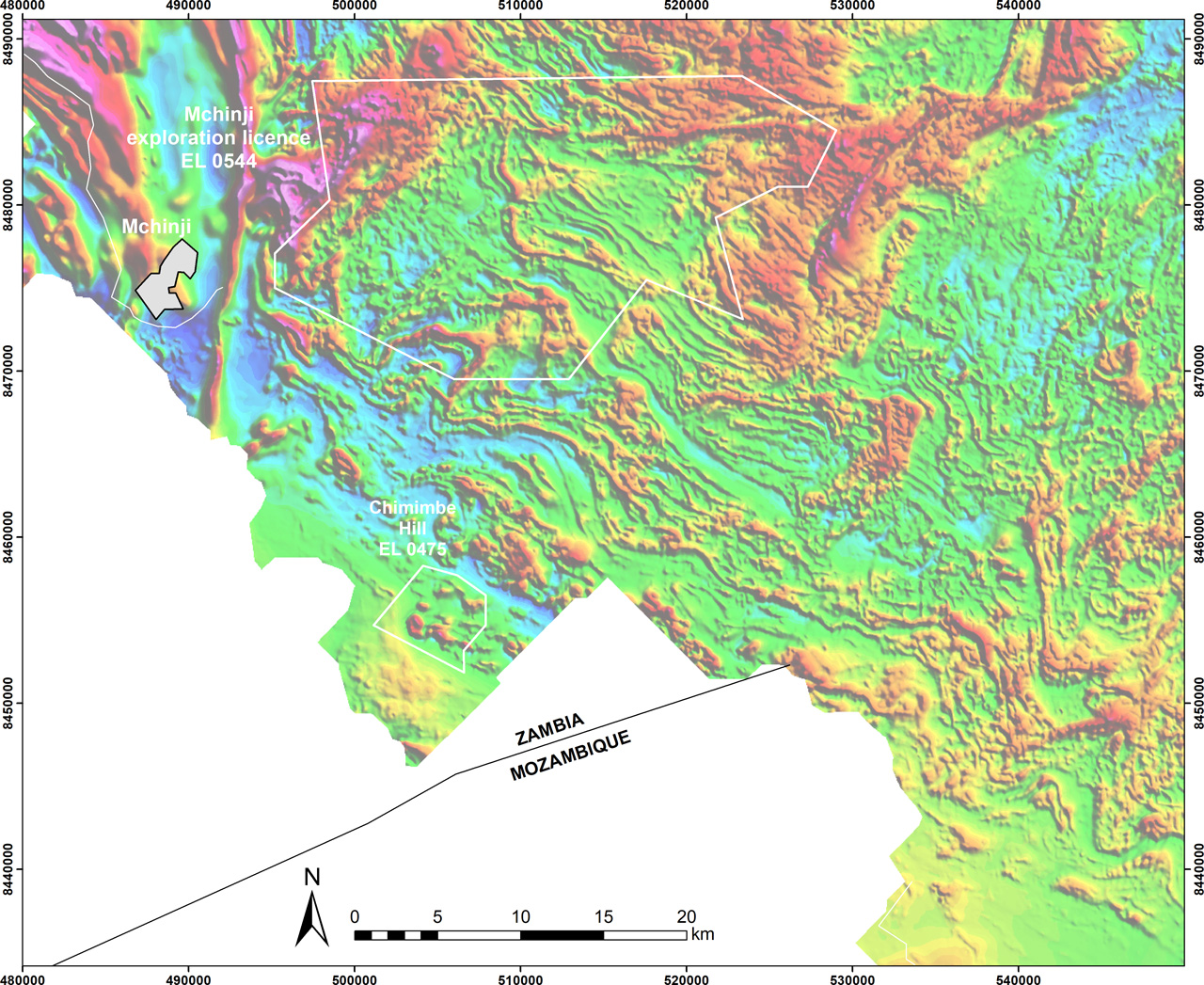Mchinji rutile-graphite-gold
Introduction
The Mchinji licence covers 434.35 km2 and is adjacent to areas with known mineral potential, some of which are licenced including the Mkango’s Chimimbe Hill nickel-cobalt-chromite licence to the south. The Mchinji licence has been granted for the exploration of rutile, ilmenite, gold, graphite, nickel, cobalt, base metals, platinum group metals, vanadium, chromium, uranium and rare earth metals.
Mkango subsidiary MKA Exploration Ltd was awarded the 868.75km2 exclusive prospecting licence EPL 0544/19 in Mchinji district on 13th May 2019. The licence was renewed in 2020 as exploration licence EL 0544/19R with the same area, and renewed again on 13th May 2022 for a further two years with a reduced area of 434.35km2.
Location
The licence is located in Mchinji District, with its western border east of the town of Mchinji. The town of Nkotakata and Kamwendo Trading Centre lies in the south of the licence, 90km along the M12 highway from Malawi’s administrative capital, Lilongwe. The M18 highway runs north from a junction with the M12 at Nkotakata. The main railway line from Zambia passes through the southwestern part of the licence alongside the M12 road and runs to the deep-water port of Nacala in Mozambique. There are numerous dirt roads and tracks offering easy access throughout the licence. Elevation is approximately 1,050–1,150m, with higher elevated parts mainly in the west, and a number of small hills standing above the broad plain of the region. East and northeast of the Mchinji licence there are large licences owned by Sovereign Services Ltd and McCourt Mining Ltd, both wholly owned Malawi-registered subsidiaries of Sovereign Metals Ltd, that host Sovereign's Kasiya and Bua rutile projects.

Historical Exploration
The earliest known work was carried out in 1908 by T.E.G. Bailey of the Imperial Institute Mineral Survey of British Central Africa. He identified the main metasupracrustal and igneous rock types, remarking that “what little evidence we now have points to a uniform granite basement” and pointed out that the gold-bearing reefs then being worked at Missale and Chifumbazi in Mozambique were in metasupracrustal rocks close to their contact with the granite.
The Anglo-American Company prospected the area in 1937, and New Consolidated Goldfields Ltd in 1957-58. Later investigations associated with the siting of water supply boreholes were confined to very small areas.
Geological mapping was carried out concurrently with geochemical drainage reconnaissance by the Geological Survey of Malawi in 1964. This work included the collection of alluvial samples at half-mile intervals at all streams and dambo (broad, grass-covered, swampy valleys) together with alluvial samples from watershed areas far from active drainage patterns. The samples were analysed for copper, lead, nickel, chromium, tin, silver, beryllium, and arsenic. Bulletin 24 of the Geological Survey Department, Malawi Ministry of Natural Resources (Thatcher, E.C. and Wilderspin, K.E., 1968) contains a geological map and a summary of the geochemical reconnaissance, and remarks that graphite deposits are particularly noteworthy in the area.
Geology and Geophysics
Virtually all geological knowledge of the licence is reported in Thatcher E.C. and Wilderspin K.E. (1968), ‘The Geology of the Mchinji-Upper Bua Plain’, Bulletin 24 of the Geological Survey Department, Malawi Ministry of Natural Resources. This publication covers Mkango’s Mchinji and Chimimbe Hill licences but extends north and east.
The surficial geology of the area is characterized by a plain of residual soils, colluvium and alluvium, punctuated by hills of granitic gneisses and quartzite, with sporadic exposures of various gneisses and schists interpreted to be of supracrustal origin. All of these rocks are believed to belong to the Proterozoic Mozambique Mobile Belt.
A dendritic pattern of watercourses and dambo, not generally controlled by the underlying geology, drains into the Ludzi and Bua rivers which run east before turning north just beyond the eastern extent of the licence.
The magnetic pattern of the licence reveals a number of major geological structures or features in the basement rocks. Some are related to a northwest-southeast trending interpreted shear belt that between the Mchinji and Chmimbe Hill licences and through the southern part of the Mchinji licence. There is also a regional east-west trending fault in the north of the licence.
The ternary radiometric image of the licence shows domains that coincide with the interpreted major geological structures. This suggests that the extensive soil cover is largely residual, offering reasonable confidence that soil geochemistry will be the best initial exploration method.
New Exploration
In June 2020, Mkango carried out a reconnaissance shallow soil sampling and auger programme within the Mchinji licence. The results demonstrate the presence of interesting grades of rutile plus anatase (both naturally occurring mineral forms of titanium dioxide: TiO2) mineralisation of up to 1.07%, with overall TiO2 grades in the range 0.51 to 4.10% in auger samples and 0.14–2.38% in soil samples; also ilmenite grades of 1.30 to 3.40% (average 1.85%) – see table below.
The grades of the TiO2-bearing minerals in the best auger hole are in the range 0.63 to 1.07% rutile plus anatase (average 0.73%) and 1.30 to 3.40% ilmenite (average 1.85%), hosted in free-dig saprolite material accessible from surface.
Twelve vertical auger holes (prefixed A- on the map above) were drilled to depths of 0.45 to 9.40m, for a total of 35.8m, from which 41 samples were collected. Eight holes were terminated at 2m depth or less due to saturated ground in or adjacent to the Ludzi river channel. The other four holes were drilled in saprolite on higher ground between the Ludzi’s tributaries.
Soil sampling was carried out in pits dug to 50cm (‘B horizon’) on a 500m staggered grid in four areas of the licence, producing 134 samples (pink dots on the map above).
Sample preparation and analysis was provided by a specialist assay laboratory, Scientific Services in Cape Town, South Africa, employing two-acid microwave digestion and ICP-OES techniques suitable for multi-element determination and following strict internal QAQC procedures inserting blanks and standards. Internal laboratory QAQC was also completed to include standards and blanks.
The highest TiO2 grades were returned by nine consecutive samples in a single auger hole (A6), drilled to a depth of 8.9m, that contain between 4.10 and 9.01% total heavy minerals (specific gravity > 2.95) and grade between 3.17 and 4.09% TiO2. These samples were processed by heavy mineral separation and magnetic separation, and the separated fractions were sent to XRD Analytical and Consulting CC in Pretoria for quantitative determination of the heavy minerals by X-ray diffraction (“XRD”). Results are given in the table below for vertical auger hole A6:
| Auger hole A6 | Total heavy minerals % |
TiO2 % |
Rutile + anatase % |
Ilmenite % |
|---|---|---|---|---|
| 0 – 1 m | 5.32 | 4.09 | 0.66 | 3.40 |
| 1 – 2 m | 4.95 | 3.74 | 0.66 | 2.87 |
| 2 – 3 m | 7.12 | 3.29 | 0.69 | 1.71 |
| 3 – 4 m | 8.04 | 3.21 | 0.66 | 1.31 |
| 4 – 5 m | 7.78 | 3.17 | 0.63 | 1.30 |
| 5 – 6 m | 9.01 | 3.24 | 0.74 | 1.41 |
| 6 – 7 m | 5.79 | 3.56 | 0.65 | 1.44 |
| 7 – 8 m | 4.10 | 3.89 | 0.85 | 1.58 |
| 8 – 8.9 m | 4.18 | 3.81 | 1.07 | 1.62 |
| Weighted average | 6.28 | 3.55 | 0.73 | 1.85 |
In October 2020, four geological teams completed 75 auger drill holes containing 581 samples and a further 446 soil samples have been collected from a soil sampling programme on a regular 500m sampling grid with 21 soil samples collected from other points of interest. The auger holes included a grid of holes centred around hole A6 (see above), drilled in June 2020 to 8.9m depth.
All samples have now been transported overland from Malawi to Scientific Services in Cape Town. Preparation of samples for heavy mineral separation is in progress, following which detailed mineralogical analysis will take place. The Company looks forward to updating the market further once it has received and evaluated the assay and mineralogical results.
Rutile Market
- Rutile, anatase and ilmenite are naturally occurring titanium dioxide (TiO2) minerals, whose main uses are 90% for pigments, 5% production of titanium metal and 5% welding. Rutile is the purest, highest-grade natural form of TiO2 and is the preferred feedstock in manufacturing titanium pigment and producing titanium metal.
- Finely powdered rutile is a brilliant white pigment and is used in paints, plastics, paper, foods, and other applications that call for a bright white colour. It has also been widely used in the production of glass, porcelain, and ceramics, as it is a valuable colouring agent. It can also be used to add colour to steels and copper alloys.
- Titanium also has specialty uses including in welding, aerospace and military applications.
- Iluka Resources Ltd (“Iluka”) reports that, when compared to current deposits and operations, the industry is facing declining grades and assemblages (the relative weightings of each mineral) for future deposits being developed. Sierra Rutile in Sierra Leone, owned by Iluka Resources Limited, is the only high-grade, large-scale operating primary-source natural rutile mine in the world.
- The rutile market fundamentals are robust with current and forecast pricing remaining strong. Iluka, in its Q2 2022 quarterly review, declared a weighted average received price for rutile of US$1,506 in the year to date, an increase of 19% over the full-year 2021 price.




